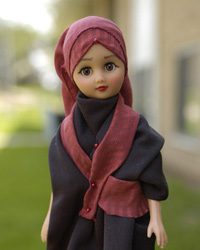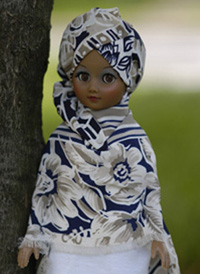 The
doll selected for Aisamah's Originals is of the
Darice Craft Designer, 15' undressed black adult doll, made
in China. Sister Aisamah uses her dolls, not only to share the
beauty offered of her talent in her artistic apparel designs.
She also introduces a respect for diversity, as well as a variety
of dress reflecting the global Muslim woman.
The
doll selected for Aisamah's Originals is of the
Darice Craft Designer, 15' undressed black adult doll, made
in China. Sister Aisamah uses her dolls, not only to share the
beauty offered of her talent in her artistic apparel designs.
She also introduces a respect for diversity, as well as a variety
of dress reflecting the global Muslim woman.
Each doll models its originality captured by its dress design,
material, color theme, style, and featuring its own Dear Beautiful
Name & FYI Lesson. She uniquely expresses the individuality
of the Islamic culture of dress as embraced by the African-American
Muslim Woman.
As an educational tool, Sister Aisamah uses her dolls to stimulate
positive communication, to channel correct teaching and
proper information of the spread of Al-Islam. The approach
is also used as a means to discourage the negative perception
that the Muslim Woman's lifestyle is that of being uneducated,
being abused, or living in oppression. Instead, she shares the
importance of recognizing the woman as the vital creation she
is, enhanced
even more so by culture and diversity that respects the valued
lifestyle of the practicing Muslim.
 In
1700, the term doll came to represent a plaything. But historically
it has held the connotation of religious or spiritual item. The
craft of doll has a long history with its origins beginning in
Africa around religious ceremonies.
In
1700, the term doll came to represent a plaything. But historically
it has held the connotation of religious or spiritual item. The
craft of doll has a long history with its origins beginning in
Africa around religious ceremonies.
The original idea of dolls was a symbolic representation of the
person. Only later on did it become a socialization tool. Dolls
have often been found in Egyptian graves dating back to 2000
BC. Egyptian tombs of wealthy families have included pottery
dolls. Dolls placed in these graves leads some to believe
that they were cherished possessions. Countries in Africa such
as South Africa, Ghana, and the Ivory Coast still make use of
the dolls for spiritual purposes, producing stilt walker and
fertility dolls.
Internationally, dolls of black people have been greatly preferred
and crafted in Australia, Brazil, Britain, Italy, England.
 In
1865 the first American doll-manufacturing enterprise was founded,
and at least ten similar operations were functioning in the United
States by 1900. These firms imported French or German bisque
and composition heads and limbs for assembly with domestically
produced bodies.
In
1865 the first American doll-manufacturing enterprise was founded,
and at least ten similar operations were functioning in the United
States by 1900. These firms imported French or German bisque
and composition heads and limbs for assembly with domestically
produced bodies.
In 1913 the Kewpie, one of the first American
character dolls (dolls fashioned to resemble
real or fictional
personages), was
introduced. These chubby-faced figures with pointed heads
became very popular. Raggedy Ann was created
in 1918.
To combat a market of non representative media
images, early in 19th century Marcus Garvey, founder of the Universal
Negro Improvement Association, founded the first African American
doll manufacturing company under his Negro Corporation. This
is the first time the slogan "black is beautiful" was
marketed. The black doll market continues to grow today as
African-Americans are developing doll consciousness.
Although the industry of toy production itself
is changing to mostly electronic items, dolls remain a presence.
Dolls represent culture, identity and history. It is these nostalgic
and sentimental values of dolls as keepsakes from childhood which
attracts most collectors. The average collector has about 1200
dolls in their possession according to the National Association
of American Doll Artists.